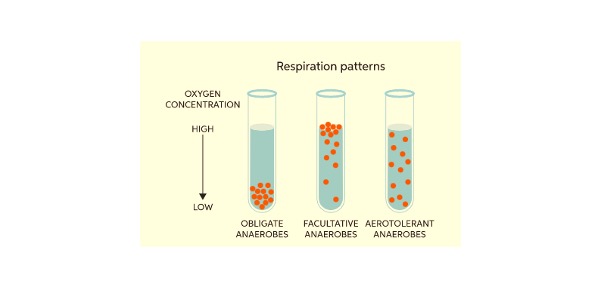Obligate Anaerobes Definition
Obligate anaerobes are organisms that can only survive in oxygen-depleted conditions. These creatures, unlike the bulk of the world’s organisms, are poisoned by oxygen. Obligate anaerobes are bacteria that may survive in a range of environments.
Many obligate anaerobes reside in the human body, in areas where oxygen levels are extremely low, such as the mouth and gastrointestinal system. These bacteria can sometimes end up in places they aren’t meant to be, causing severe illness.
Bacteria that cause gangrene and a variety of other illnesses are examples of obligate anaerobes. The Clostridium genus of bacteria, which causes gangrene, tetanus, botulism, colitis, and other severe diseases, is seen on a microscope slide.
Why Obligate Anaerobes are Killed in Oxygen?
Obligate anaerobes, unlike obligate aerobes, which require oxygen to survive, are poisoned by oxygen. Unlike many organisms that flourish in oxygenated environments, obligate anaerobes lack many essential enzymes that help the cell detoxify oxygen.
In the presence of water, oxygen creates a number of by-products, including hydrogen peroxide (H2O2). Hydrogen peroxide is a weak acid that affects a variety of anaerobic cell enzymes. The cell becomes too acidic to operate when exposed to high quantities of oxygen. This is why obligate anaerobes are often found in low-oxygen environments.
Their metabolic enzymes aren’t sufficiently hindered by the alteration oxygen produces at this level. Aerobic bacteria and eukaryotes have a variety of oxygen defense systems. Superoxide dismutase, catalase, and peroxidase are enzymes that help deal with oxygen by-products by retaining them as oxygen gas or converting them to harmless water molecules.
Evolutionary Significance of Obligate Anaerobes
The existence of obligatory anaerobes is a key piece of evidence in the evolution of life on Earth. While we presently have a substantial amount of oxygen in our atmosphere, this may not have always been the case.
The presence of obligate anaerobes now implies that there was previously significantly less oxygen in the atmosphere, allowing bacteria to thrive without oxygen-facilitating enzymes. According to the idea, the emergence of photosynthetic organisms coincided with an increase in the amount of oxygen in the environment.
Where Obligate Anaerobes Exist?
Obligate anaerobes may now be found in a wide range of habitats, all of which have one thing in common: low oxygen levels. Many obligate anaerobes may be found in the soil, away from the top layers, where oxygen is abundant.
Animals’ guts, mouths, and reproductive systems include other obligate anaerobes. Because they are not accessible to blood arteries, these areas have little or no oxygen. When these bacteria get access to the body’s sterile interior regions, they can cause a serious illness. This usually occurs when an organism is injured, allowing germs to gain access to previously closed-off regions.
The germs will perish in the presence of the oxygenated blood that gets to the region if the incision is closed promptly and sterilely. It offers obligate anaerobes a location to reproduce and flourish if the wound has no blood flow and is exposed to them.
Many of these obligate anaerobes produce poisons that cause normal tissue to die. This exacerbated the illness and allowed the germs to propagate. If left untreated, many obligate anaerobe infections can be fatal.
Finding Obligate Anaerobes
Obligate Anaerobes are exclusively found in low-oxygen conditions. In a world filled with oxygen, it may appear that obligate anaerobes are difficult to come by. However, the reverse is true. Obligate anaerobes may be found hiding away from oxygen in nearly any habitat.
A simple experiment like the one below may be used to discover the obligate anaerobes in any sample. Different species of bacteria may be found in a sample cultured in a test tube with a loosely closed lid.

The tube’s top layer of growth fluid can be saturated with oxygen thanks to the loose cover. The oxygen concentration is lowest at this end of the test tube. To reach the bottom of the test tube, it must first diffuse across the whole column of water.
The oxygen level will naturally be the lowest here if it is not disturbed or aerated in any way. Furthermore, oxygen-using organisms in the tube will prefer to concentrate towards the top. At all levels, these organisms will deplete the oxygen in the test tube.
This aids in driving the oxygen gradient towards the tube’s top. As a result, scientists looking for obligate anaerobes just need to check the sample’s least oxygenated area. Other bacteria, such as facultative anaerobes, which can survive in a variety of circumstances and may or may not require or utilize oxygen.
Obligate Anaerobes Citations
- Responses of Clostridia to oxygen: from detoxification to adaptive strategies. Environ Microbiol . 2021 Aug;23(8):4112-4125.
- Lactate dehydrogenase and malate dehydrogenase: Potential antiparasitic targets for drug development studies. Bioorg Med Chem . 2021 Nov 15;50:116458.







